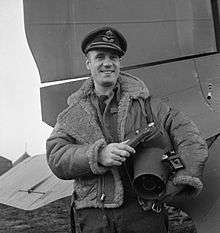Fairchild K-20


The K-20 is an aerial photography camera used during World War II, e.g., from the Enola Gay's tail gunner position of the mushroom cloud over Hiroshima.[1] Designed by Fairchild Camera and Instrument, approximately 15,000 were manufactured under licence for military contract by Folmer Graflex Corporation in Rochester, NY between 1941 and 1945. The K-20 uses a 5.25"x20 to 5.25"x200 foot Roll Film, with an image size of 4x5 inches. Lenses were 6 3/8" f/4.5 with an adjustable diaphragm and were non interchangeable, these were made by Kodak, Ilex, or Bausch & Lomb, as available at the time of order. The camera featured the use of a vacuum to keep the film flat.
Earlier aerial cameras, from the World War I era, included the Kodak K1, with focal plane shutter, the Fairchild K3, K3A, K3B etc., with in-lens shutter to eliminate distortion, K5 etc., some of which used individual glass plates, some individual sheet film, and some roll film.
Similar cameras, from the World War II era: K17, K18, K19, K21, K22, F20, F40, F56, etc., many making 9" x 9" or 9" x 18" images using 9"+ roll film.[2]
See also
- Aerial archaeology
- Aerial landscape art
- Aviation photography
- Bird's-eye view
- Graflex
- Orthophoto
- Pictometry
- Reconnaissance
- F24 camera
References
- ↑ http://blog.nuclearsecrecy.com/wp-content/uploads/2011/12/1945-Groves-and-LeMay-teletype-about-Hiroshima.pdf
- ↑ "K-17, K-18, K-19B, and K-22 Aerial Cameras". Mysite.verizon.net. 2010-08-02. Retrieved 2012-05-18.
External links
| Wikimedia Commons has media related to Fairchild K-20. |